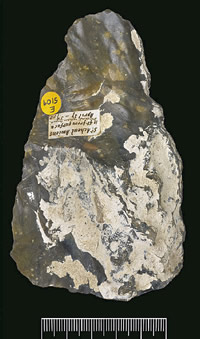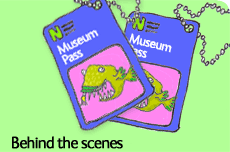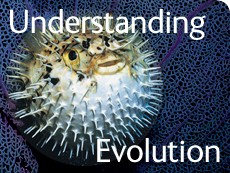The axe that revealed the age of humankind
How long have humans been living on Earth? This question has been debated for centuries but specimens at the Museum can help provide an answer.
One crucial specimen is a flint hand axe that was discovered in 1859, the same year that Charles Darwin published On the Origin of Species. This axe provided the first strong evidence that humans have been living on the planet for much longer than previously thought.

Flint hand axe uncovered in 1859 that helped reveal the ancient age of humankind
Until the 19th century, most people believed humans had been on Earth for only a few thousands of years. However, this hand axe, probably used by our ancient relatives to cut and prepare meat and skins, was uncovered together with woolly mammoth and rhino remains and showed that humans were living on Earth many thousands of years earlier.
Two geologists
The 2 geologists Joseph Prestwich and John Evans made the discovery and presented the axe at a lecture to the Royal Society.
From then on it began to be more widely accepted that humans had existed on Earth at a much earlier date than previously thought. Since then scientists have gathered extensive evidence for human evolution.
Age of tools
The hand axe is now thought to be about 400,000 years old. Much older stone tools have since been found in Africa by archaeologists. The oldest known artefacts in the world were found in Ethiopia and were made by our very distant ancestors over 2.5 million years ago.
First photo evidence

Workers point to the hand axe uncovered in the gravel mine in 1859. © © Bibliotheque Amiens Metropole
The hand axe was uncovered in 1859 in northern France by workers mining gravel. Crucially, before it was removed from the ground it was photographed.
This meant that scientists could use information such as the position of the item, what other artefacts and fossils were close by, and the type of surrounding rock, to investigate the item scientifically. This was the very first time photography was used to provide precise location evidence for an archaeological discovery.
Donated to Museum
Joseph Prestwich made many other important geological discoveries, and after his death in 1896 his large collection of fossils and other artefacts was donated to the Natural History Museum.
Forgotten specimen?
The axe specimen lay unheralded in the collections for over 100 years and was uncovered again by researchers Robert Kruszynski and Clive Gamble in 2009, and they published an article about it in the journal Antiquity.
Kruszynski says of their uncovering of the specimen, 'We were able to reconstruct the occasion of the very first endorsement of the great antiquity of human tool-making.'
Toolbox

In World War II the Museum was used as a secret base to develop new gadgets for allied spies, including an exploding rat!
